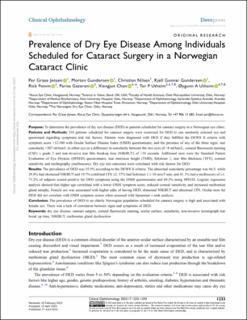| dc.contributor.author | Graae Jensen, Per | |
| dc.contributor.author | Gundersen, Morten | |
| dc.contributor.author | Nilsen, Christian | |
| dc.contributor.author | Gundersen, Kjell Gunnar | |
| dc.contributor.author | Potvin, Rick | |
| dc.contributor.author | Gazerani, Parisa | |
| dc.contributor.author | Chen, Xiangjun | |
| dc.contributor.author | Utheim, Tor Paaske | |
| dc.contributor.author | Utheim, Øygunn Aass | |
| dc.date.accessioned | 2023-05-02T12:22:00Z | |
| dc.date.available | 2023-05-02T12:22:00Z | |
| dc.date.created | 2023-04-27T09:45:53Z | |
| dc.date.issued | 2023 | |
| dc.identifier.citation | Clinical Ophthalmology. 2023, 17 1233-1243. | en_US |
| dc.identifier.issn | 1177-5467 | |
| dc.identifier.uri | https://hdl.handle.net/11250/3065779 | |
| dc.description.abstract | Purpose: To determine the prevalence of dry eye disease (DED) in patients scheduled for cataract surgery in a Norwegian eye clinic.
Patients and Methods: 218 patients scheduled for cataract surgery were examined for DED in one randomly selected eye and questioned regarding symptoms and risk factors. Patients were diagnosed with DED if they fulfilled the DEWS II criteria with symptom score >12/100 with Ocular Surface Disease Index (OSDI) questionnaire, and the presence of any of the three signs: tear osmolarity >307 mOsm/L in either eye or a difference in osmolarity between the two eyes of >8 mOsm/L, corneal fluorescein staining (CSF) ≥ grade 2 and non-invasive tear film breakup time (NIKBUT) of <10 seconds. Additional tests were the Standard Patient Evaluation of Eye Dryness (SPEED) questionnaire, tear meniscus height (TMH), Schirmer 1, tear film thickness (TFT), corneal sensitivity and meibography (meiboscore). Dry eye test outcomes were correlated with risk factors for DED.
Results: The prevalence of DED was 55.5% according to the DEWS II criteria. The abnormal osmolarity percentage was 66.5, while 29.8% had shortened NIKBUT and 19.7% exhibited CFS ≥2. 57% had Schirmer 1 ≤ 10 mm/5 min, and 81.1% had a meiboscore of ≥1. 71.2% of subjects scored positive for DED symptoms using the OSDI questionnaire and 69.3% using SPEED. Logistic regression analysis showed that higher age correlated with a lower OSDI symptom score, reduced corneal sensitivity and increased meibomian gland atrophy. Female sex was associated with higher odds of having DED, abnormal NIKBUT and abnormal CFS. Ocular tests for DED did not correlate with OSDI symptom scores when assessed with Spearman`s rank analysis.
Conclusion: The prevalence of DED in an elderly Norwegian population scheduled for cataract surgery is high and associated with female sex. There was a lack of correlation between signs and symptoms of DED. | en_US |
| dc.language.iso | eng | en_US |
| dc.publisher | Dove Press | en_US |
| dc.relation.ispartofseries | Clinical Ophthalmology; | |
| dc.relation.uri | https://www.dovepress.com/articles.php?article_id=83360 | |
| dc.rights | Navngivelse-Ikkekommersiell 4.0 Internasjonal | * |
| dc.rights.uri | http://creativecommons.org/licenses/by-nc/4.0/deed.no | * |
| dc.title | Prevalence of Dry Eye Disease Among Individuals Scheduled for Cataract Surgery in a Norwegian Cataract Clinic | en_US |
| dc.type | Peer reviewed | en_US |
| dc.type | Journal article | en_US |
| dc.description.version | publishedVersion | en_US |
| cristin.ispublished | true | |
| cristin.fulltext | original | |
| cristin.qualitycode | 1 | |
| dc.identifier.doi | https://doi.org/10.2147/OPTH.S407805 | |
| dc.identifier.cristin | 2143727 | |
| dc.source.journal | Clinical Ophthalmology | en_US |
| dc.source.volume | 17 | en_US |
| dc.source.pagenumber | 1233-1243 | en_US |

